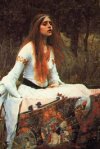 |
The Lady of Shalott - study guide |
Introduction
Your teacher will advise you on which, and how many, activities to attempt. If you wish to work traditionally these activities can be done in an exercise book, or as a booklet using your own skills in illustration and writing. If you wish to use computer software for your work, this is quite appropriate. A separate contents list and page numbering would help. Some tasks may work well as speaking and listening activities; you are encouraged to present these “live” or make use of tape-recording or multi-media software recording to show your work. In such cases, where the guide refers to writing, you may respond by speaking. Problem-solvingExplain the “whisper” and the “curse” in the first stanza (verse) of Part II. Tell what the Lady knows, and what she does not know (until it happens). The first stanza of Part III (which begins: “A bow-shot from her bower-eaves”) is the odd one out. Can you explain why? If you are really stuck, click here for a clue. If you think you know the answer click below to check. Darkness and lightThis is a poem of contrasts of dark and light. Choose one stanza which is full of darkness and another which is full of light. Copy these out, and illuminate or illustrate the stanzas. “Or is she known in all the land?”Apparently not, but some people know something. Write descriptions of the Lady as they might be given by a reaper (Part I, Stanza iv) and Lancelot (last stanza, final part). The secret diary of the Lady of ShalottWhile the Lady weaves and watches her mirror, many thoughts must pass through her mind. Imagine that she keeps a secret diary. Write a number of selected entries. After each one, write down the part of the poem, and the stanza, on which it is based. The Lady of Shalott - the movieThis poem could make a very exciting film. Write a shooting script for such a cinema treatment. You should describe, shot by shot: what will be shown; special effects (visual or sound); music; speech, and anything else you wish to include. Describe the physical appearance of the actress and actor who would play the Lady and Lancelot. Describe also
You might want to add some scenes - perhaps flashbacks with dialogue, showing how and why the Lady is in the tower. Follow-up (optional): Now write a review of this cinema version. You may be complimentary or critical. Language studyList all of the words in the poem with which you are not familiar. Try to find out what they mean. Here are a few to challenge you:
Find some others for yourself. Some people say that you can't start a sentence with “and”. Is this true? Check the use of “and” throughout this poem, and make up your own mind. See if you can find lists of details in the poem. How do these help you to visualize (“see”) the story? Make a list of words which seem old-fashioned. How do these help create the atmosphere of the poem? The poem was published in 1833, but it is set in an earlier time. Can you find language that shows that the poem was written much later than the time in which it is set? ResearchTennyson based this poem on much older narratives about King Arthur and the knights of the Round Table.
Choose any other Arthurian story. Re-write it in your own words (either first or third person). At the end, write down the sources on which you based your version, and explain how you tried to adapt it. Further readingTennyson
T.H. White
Essential Viewing
© Andrew Moore, 2002; Contact me
|

